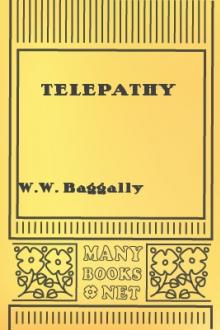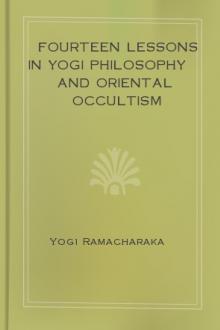Telepathy by W. W. Baggally (e reader manga .txt) 📕

- Author: W. W. Baggally
- Performer: -
Book online «Telepathy by W. W. Baggally (e reader manga .txt) 📕». Author W. W. Baggally
I attended a series of performances at the Alhambra, and took down the questions and answers in order, if possible, to discover the code. On witnessing a first performance the spectator might be led to believe that word-coding alone is at the bottom of the mystery, but if notes are taken at a number of performances he will find that the same question is answered differently time after time.
From my experiments with the Zancigs I came to the conclusion that although the alleged transmission of thought might possibly depend on a code or codes which I was unable to unravel, yet their performance was of such a nature that it was worthy of serious scientific examination. On the assumption that they possessed genuine telepathic powers it would be a pity that the opportunity of investigating their claim should be missed. I therefore set myself to work to arrange with Mr. Alfred Moul, managing director of the Alhambra, and Mr. Zancig for some experiments to be tried before a Committee of the members of the Society for Psychical Research.
An article appeared in the Daily Mail, inspired evidently by Mr. Moul, from which I now quote:—
"We have suggested to Mr. Zancig that in preference to inquiries into telepathy by unskilled persons he should place himself in the hands of the Society for Psychical Research, of which Mr. Gerald Balfour is the President, and of which Sir Oliver Lodge, Sir William Crookes, and other distinguished scientists are leading members. Mr. Zancig has informed us that he has already received a communication from that Society, and that he was entirely willing to place himself and Madame Zancig at the disposal of the Society for a thoroughly scientific series of tests."
The investigation by the Society for Psychical Research, at which I was present, took place on the 18th January 1907. I regret that I cannot give an account of what took place at this meeting, as it was mutually arranged between Mr. Moul and the S.P.R. that the results should not be divulged. They appeared, however, sufficiently favourable to some of the members present (though not to all) to induce them to subsequently form an unofficial Committee to carry out further tests. These unofficial experiments did not take place till 26th July 1907.
In the meantime I continued my own private experiments. A striking one is the following. I was in the balcony of the Alhambra on the 19th January 1907, and when Mr. Zancig came to that part of the house I handed him a piece of paper on which I had written the word "Istapalapan." I took care that he should not see the word previously to my giving him the paper. Zancig remarked to me in a whisper, "This is a long word." Owing to the distance from his wife it could not have been possible for her to overhear these words. Then Mr. Zancig called out, "Spell this." Madame Zancig immediately wrote on the blackboard which was on the stage "Istapala," and when she came to the second "p" she wrote "f" and then "san." I have often noticed that when Madame Zancig makes a mistake in a letter or number there is a similarity in the form of the letter or number to that which was to be transmitted; thus, she would put down "f" for "p," "7" for "9." "fsan" in this case is very like "pan," and Mr. Zancig may have mistaken the letters. I fail to understand how in this experiment he was able to code such a long word as "Istapalafsan" by the simple words "Spell this." It would appear as if Madame Zancig really saw what Mr. Zancig was looking at. The reader will recollect that in his preliminary remarks at each of his performances Zancig says, "What I see, Madame Zancig sees."
I have several times observed this alleged peculiarity, notably so on the occasion of the tests at the Gramophone offices, which took place on the 22nd February 1907, and at which I was one of the members of the Committee. Mr. and Mrs. Zancig were divided by a large screen. They could not see each other. A recording trumpet was placed near each, into which they spoke. A table was placed by the side of Mr. Zancig on which a great number of articles had been placed by the members of the Committee. Madame Zancig with great rapidity named the articles as Mr. Zancig took them up in answer to his "What is this? and this?" etc. An incident which struck me as remarkable was the following. Mr. Zancig raised a pencil, saying, "What is this?" and after Madame Zancig had correctly stated what it was, he took up immediately (not in the vicinity of the pencil, but some distance from it) a case, and said, "And this?" Instead of naming the article Madame Zancig proceeded to enumerate in their proper order the articles that lay between the two articles which Mr. Zancig had taken up. Thus, a pencil, a seal, a penknife, a case. It appeared as if Madame Zancig had actually seen the articles over which her husband had passed his hand.
An excellent test was the following. Dr. W. M'Dougall, a member of the Council of the S.P.R., who was present at these tests, borrowed a book from one of the members of the Committee. He came to the side of the screen where Mr. Zancig stood, opened the book at a certain page, then pointed to the middle of a line in the centre of the page. Mr. Zancig, without taking the book in his hand, glanced at the line, then Dr. M'Dougall shut the book, took it to the other side of the screen, and handed it closed to Madame Zancig. Mr. Zancig remained absolutely silent, placed his hand against his forehead, and appeared to make a strong mental effort. Madame Zancig, after the lapse of a minute, opened the book at the proper page and began reading at the word in the middle of the line that had been chosen by Dr. M'Dougall. Some members of the Committee and I stood quite close to Mr. Zancig. We did not hear him utter a sound. He could not be seen by Madame Zancig owing to the screen.
I was present at the matinée performance given under the auspices of the Daily Mirror newspaper at the Alhambra. Dr. H., principal surgeon of a well-known hospital, handed to Mr. Zancig a set of skeins of silk of different colours. These were then passed on to Madame Zancig, who was on the stage. Dr. H. pointed silently to a skein of silk of a corresponding set which he had retained, and which he took care Madame Zancig could not see. Mr. Zancig, who preserved absolute silence, and remained motionless, looked at the colour of the skein, and in the space of half a minute his wife picked out a skein of the corresponding colour from the set that she had in her possession. This test was tried successfully three times. I particularly took note that Mr. Zancig remained silent and motionless, retaining the same position of his body during the course of the three experiments.
I have tried tests with Mr. and Madame Zancig in the transmission of diagrams. I took with me to a private house to which I was invited an envelope containing cards with diagrams on them. Madame Zancig sat behind a large screen at the end of the room. By her side sat a lady, a friend of mine, who watched Madame Zancig and saw that she did not move from her chair. Mr. Zancig stood close to me near the other end of the room. I presented the envelope to him, retaining it in my hand. He drew out one of the cards on which was a diagram not known either to him or to me till he looked at it. He fixed his gaze intently on it, remained motionless, and in a whisper said to me, "Please say ready." I called out, "Ready," and his wife then drew a diagram on a piece of paper, at the same time saying, "Something like half a moon."
Mr. Zancig then drew another card from the envelope. This time he did not speak, but nodded his head once, and I called out, "Ready." Madame Zancig thereupon observed, "It is a square within a square." The diagram that Mr. Zancig was looking at was this:
his wife drew this:
Two more cards were then drawn, but Madame Zancig did not succeed; she got absolutely wrong drawings.
At a public performance at Eastbourne I handed Mr. Zancig this diagram:
He called out, "Draw this." Madame Zancig, who was on the platform, said, "It is something like this." She made a motion with her right arm like drawing a capital V; she then drew it on the blackboard. After this she slowly drew a horizontal line through the V, thus:
Mr. Zancig said, "Give the number." She then placed a 2 in the proper position. He then called out, "Give the rest." She thereupon placed the a under the line, thus:
Mr. Zancig said, "What more?" His wife placed the sign of + correctly, but she rubbed it out several times as if in doubt. Finally she put down the sign of + and a capital X, so that her drawing appeared like this:
I have had many other experiments with this gifted couple, but have not yet obtained the crucial test of getting Mr. Zancig to be in a distant room with closed doors, while his wife was in another room. The possibility of their using a sound code at one time and a visual code at another is therefore not entirely precluded.
Although I have been quite unable to discover the methods by which they can possibly communicate when a visual and a sound code are not detected, yet I will reserve my ultimate opinion until I obtain tests under the crucial conditions that I have named.
Not only did I personally meet with difficulties in endeavouring to explain the performances of Mr. and Madame Zancig, but also the members of the unofficial Committee that I have referred to. I now give an extract from our unofficial report.
"... It must be remembered that the antecedent probabilities in favour of a code to explain all performances of this kind are enormous.
"While we are of opinion that the records of experiments in telepathy made by the Society for Psychical Research and others raise a presumption for the existence of such a faculty at least strong enough to entitle it to serious scientific attention, the most hopeful results hitherto obtained have not been in any way comparable as regards accuracy and precision with those produced by Mr. and Madame Zancig. Further, there is, so far as we are aware, no case of any public performers (including certain recent examples) where the use of a code or apparatus has not been more or less readily discoverable or clearly to be inferred. In considering, therefore, the claim of Mr. and Madame Zancig to the possession of a genuine telepathic faculty, one is faced by the initial difficulty that such a faculty must be regarded as unique





Comments (0)